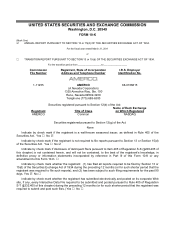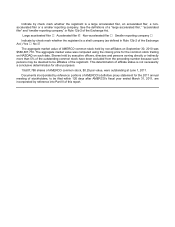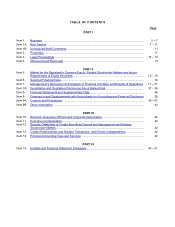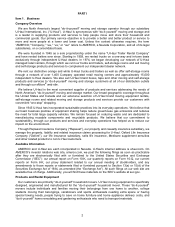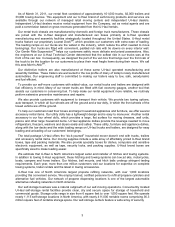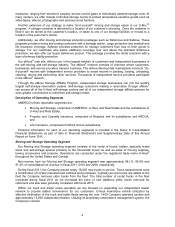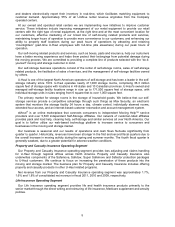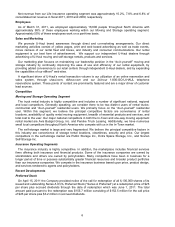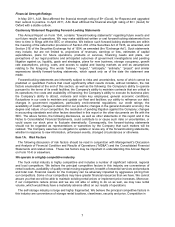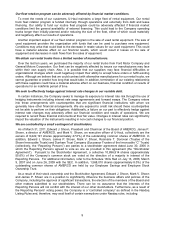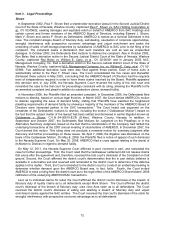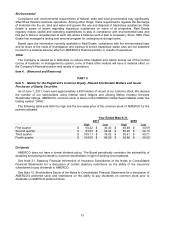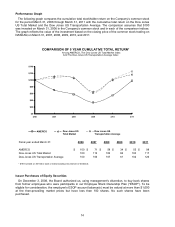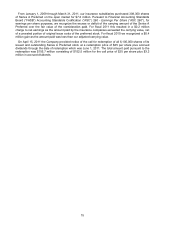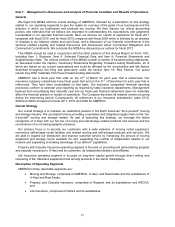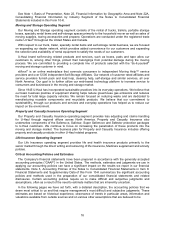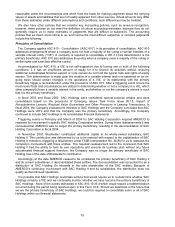U-Haul 2011 Annual Report Download - page 14
Download and view the complete annual report
Please find page 14 of the 2011 U-Haul annual report below. You can navigate through the pages in the report by either clicking on the pages listed below, or by using the keyword search tool below to find specific information within the annual report. 9
Our fleet rotation program can be adversely affected by financial market conditions.
To meet the needs of our customers, U-Haul maintains a large fleet of rental equipment. Our rental
truck fleet rotation program is funded internally through operations and externally from debt and lease
financing. Our ability to fund our routine fleet program could be adversely affected if financial market
conditions limit the general availability of external financing. This could lead to the Company operating
trucks longer than initially planned and/or reducing the size of the fleet, either of which could materially
and negatively affect our results of operations.
Another important aspect of our fleet rotation program is the sale of used rental equipment. The sale of
used equipment provides the organization with funds that can be used to purchase new equipment.
Conditions may arise that could lead to the decrease in resale values for our used equipment. This could
have a material adverse effect on our financial results, which would result in losses on the sale of
equipment and decreases in cash flows from the sales of equipment.
We obtain our rental trucks from a limited number of manufacturers.
Over the last ten years, we purchased the majority of our rental trucks from Ford Motor Company and
General Motors Corporation. Our fleet can be negatively affected by issues our manufacturers may face
within their own supply chain. Also, it is possible that our suppliers may face financial difficulties or
organizational changes which could negatively impact their ability to accept future orders or fulfill existing
orders. Although we believe that we could contract with alternative manufacturers for our rental trucks, we
cannot guarantee or predict how long that would take. In addition, termination of our existing relationship
with these suppliers could have a material adverse effect on our business, financial condition or results of
operations for an indefinite period of time.
We seek to effectively hedge against interest rate changes in our variable debt.
In certain instances, the Company seeks to manage its exposure to interest rate risk through the use of
hedging instruments including interest rate swap agreements and forward swaps. The Company enters
into these arrangements with counterparties that are significant financial institutions with whom we
generally have other financial arrangements. We are exposed to credit risk should these counterparties
not be able to perform on their obligations. Additionally, a failure on our part to effectively hedge against
interest rate changes may adversely affect our financial condition and results of operations. We are
required to record these financial instruments at their fair value. Changes in interest rates can significantly
impact the valuation of the instruments resulting in non-cash changes to our financial position.
We are controlled by a small contingent of stockholders.
As of March 31, 2011, Edward J. Shoen, President and Chairman of the Board of AMERCO, James P.
Shoen, a director of AMERCO, and Mark V. Shoen, an executive officer of U-Haul, collectively are the
owners of 9,222,191 shares (approximately 47.0%) of the outstanding common shares of AMERCO. In
addition, Edward J. Shoen, James P. Shoen, Mark V. Shoen, Rosmarie T. Donovan (Trustee of the
Shoen Irrevocable Trusts) and Dunham Trust Company (Successor Trustee of the Irrevocable “C” Trusts)
(collectively, the “Reporting Persons”) are parties to a stockholder agreement dated June 30, 2006 in
which the Reporting Persons agreed to vote as one as provided in this agreement (the “Stockholder
Agreement”). Pursuant to the Stockholder Agreement, a collective 10,896,914 shares (approximately
55.6%) of the Company’s common stock are voted at the direction of a majority in interest of the
Reporting Persons. For additional information, refer to the Schedule 13Ds filed on July 13, 2006, March
9, 2007 and on June 26, 2009 with the SEC. In addition, 1,568,010 shares (approximately 8.0%) of the
outstanding common shares of AMERCO are held by our Employee Savings and Employee Stock
Ownership Trust.
As a result of their stock ownership and the Stockholder Agreement, Edward J. Shoen, Mark V. Shoen
and James P. Shoen are in a position to significantly influence the business affairs and policies of the
Company, including the approval of significant transactions, the election of the members of the Board and
other matters submitted to our stockholders. There can be no assurance that the interests of the
Reporting Persons will not conflict with the interest of our other stockholders. Furthermore, as a result of
the Reporting Persons’ voting power, the Company is a “controlled company” as defined in the Nasdaq
Listing Rules and, therefore, may avail itself of certain exemptions under Nasdaq rules, including


